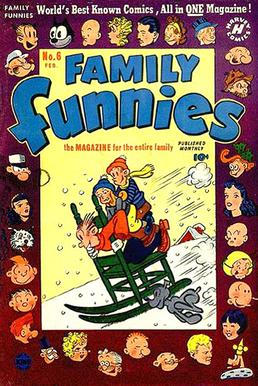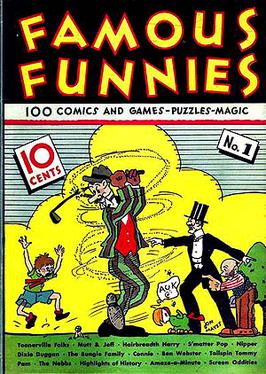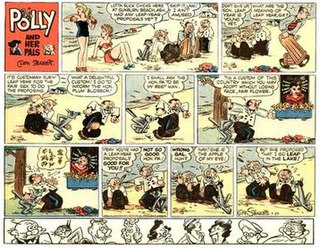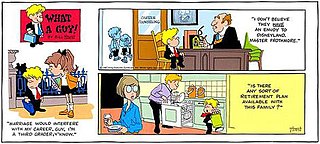A comic strip is a sequence of cartoons, arranged in interrelated panels to display brief humor or form a narrative, often serialized, with text in balloons and captions. Traditionally, throughout the 20th and into the 21st century, these have been published in newspapers and magazines, with daily horizontal strips printed in black-and-white in newspapers, while Sunday papers offered longer sequences in special color comics sections. With the advent of the internet, online comic strips began to appear as webcomics.
A daily strip is a newspaper comic strip format, appearing on weekdays, Monday through Saturday, as contrasted with a Sunday strip, which typically only appears on Sundays. They typically are smaller, 3–4 grids compared to the full page Sunday strip and are black and white.

A topper in comic strip parlance is a small secondary strip seen along with a larger Sunday strip. In the 1920s and 1930s, leading cartoonists were given full pages in the Sunday comics sections, allowing them to add smaller strips and single-panel cartoons to their page.

Mickey Finn was an American comic strip created by cartoonist Lank Leonard, which was syndicated to newspapers from April 6, 1936 to September 10, 1977. The successful lighthearted strip struck a balance between comedy and drama. It was adapted to a 400-page Little Big Book and was reprinted in several comic book series throughout the 1930s and 1940s.
The Eastern Color Printing Company was a company that published comic books, beginning in 1933. At first, it was only newspaper comic strip reprints, but later on, original material was published. Eastern Color Printing was incorporated in 1928, and soon became successful by printing color newspaper sections for several New England and New York papers. Eastern is most notable for its production of Funnies on Parade and Famous Funnies, two publications that gave birth to the American comic book industry.

Dan Dunn is a fictional detective created by Norman W. Marsh. He first appeared in Detective Dan: Secret Operative No. 48, a proto-comic book from 1933, produced by Humor Publishing. He subsequently appeared in newspaper comic strips from 1933 to 1943.

Tillie the Toiler is a newspaper comic strip created by cartoonist Russ Westover who initially worked on his concept of a flapper character in a strip he titled Rose of the Office. With a title change, it sold to King Features Syndicate which carried the strip from January 3, 1921, to March 15, 1959.

Toots and Casper is a family comic strip by Jimmy Murphy, distributed to newspapers for 38 years by King Features Syndicate, from December 17, 1918 to December 30, 1956. The strip spawned many merchandising tie-ins, including books, dolls, paper dolls, pins, bisque nodders and comic books.
Comic strip formats vary widely from publication to publication, so that the same newspaper comic strip may appear in a half-dozen different formats with different numbers of panels, different sizes of panels and different arrangement of panels.

Famous Funnies is an American comic strip anthology series published from 1934 to 1955 with two precursor one-shots appearing in 1933–1934. Published by Eastern Color Printing, Famous Funnies is considered by popular culture historians as the first true American comic book, following seminal precursors.

Polly and Her Pals is an American comic strip, created by cartoonist Cliff Sterrett, which ran from December 4, 1912, until December 7, 1958. It is regarded as one of the most graphically innovative strips of the 20th century. It debuted as Positive Polly on December 4, 1912, in William Randolph Hearst's newspapers, initially the New York Journal, and was later distributed by King Features Syndicate. The title changed to Polly and Her Pals on January 17, 1913.

Mike and Ike (They Look Alike) was a comic strip by Rube Goldberg, who introduced the identical twin characters in the San Francisco Bulletin on September 29, 1907. The strip was syndicated by the McClure Syndicate from March 9, 1913, to February 1, 1914.

Life's Like That was a gag panel by Fred Neher which found humor in life's foibles. Spanning five decades -- from October 1, 1934 to August 20, 1977 — the panel was initially distributed by Consolidated News Features, and later by the Bell-McClure Syndicate and the United Feature Syndicate.

Alvah Posen was an American cartoonist on several comic strips, but he is best known for his 1933-1960 comic strip Sweeney & Son and as co-producer of the now-lost Marx Brothers film, Humor Risk (1921).

What a Guy! is an American comic strip created by Bill Hoest and Bunny Hoest, the team responsible for The Lockhorns and Agatha Crumm. It began in March 1987, just over a year before Hoest's death in 1988.
The Sunday Funnies is a publication reprinting vintage Sunday comic strips at a large size (16"x22") in color. The format is similar to that traditionally used by newspapers to publish color comics, yet instead of newsprint, it is printed on a quality, non-glossy, 60-pound offset stock for clarity and longevity. Featured are classic American comic strips from the late 19th century to the 1930s. The publication's title is taken from the generic label often used for the color comics sections of Sunday newspapers.
The Register and Tribune Syndicate was a syndication service based in Des Moines, Iowa, that operated from 1922 to 1986, when it was acquired by King Features to become the Cowles Syndicate affiliate. At its peak, the Register and Tribune Syndicate offered newspapers some 60 to 75 features, including editorial cartoonist Herblock, comic strips, and commentaries by David Horowitz, Stanley Karnow, and others.

Charles H. Winner, better known as Doc Winner, was an American cartoonist, notable for his comic strips Tubby and Elmer, plus his contributions to Thimble Theatre, Barney Google and other King Features strips.

Norman Winfield Marsh was an American cartoonist and comic strip creator known for his character Dan Dunn, a hardboiled detective.
The New York World was one of the first newspapers to publish comic strips, starting around 1890, and contributed greatly to the development of the American comic strip. Notable strips that originated with the World included Richard F. Outcault's Hogan's Alley, Rudolph Dirks' The Captain and the Kids, Denys Wortman's Everyday Movies, Fritzi Ritz, Gus Mager's Hawkshaw the Detective, Victor Forsythe's Joe Jinks, and Robert Moore Brinkerhoff's Little Mary Mixup.

















